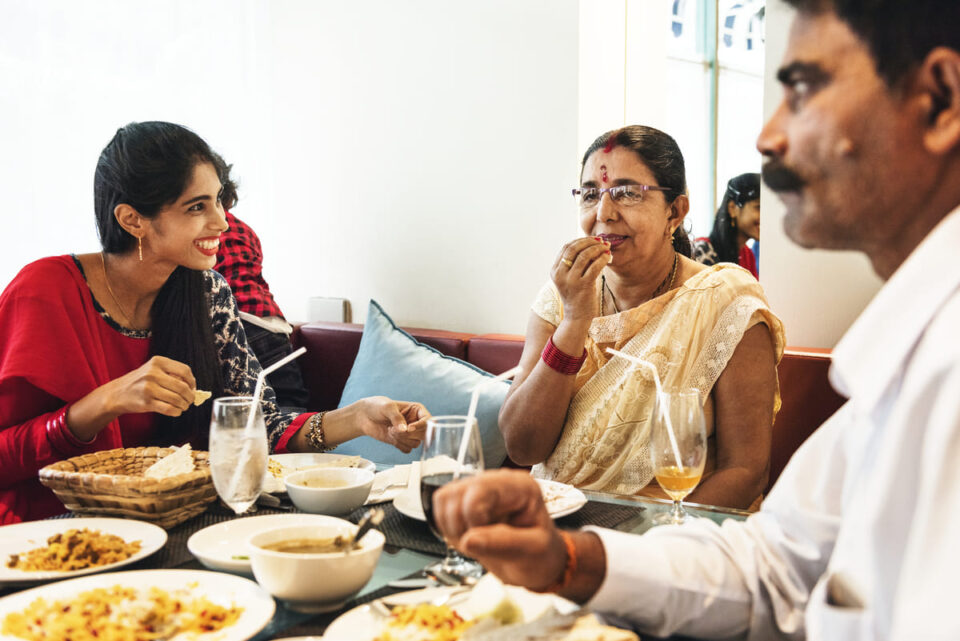You’re doing it wrong. Yes, you—hunched over your desk, shovelling food into your mouth while scrolling through emails. Or you, collapsed on the couch, mindlessly chewing as the TV flickers. This isn’t eating. It’s refuelling, as joyless as filling up a car.
But what if I told you that the simple act of eating could be transformative? Could it heal your body, calm your mind, and nourish your soul? This is the promise of Ayurvedic dining etiquette, which is more relevant today than ever.
Suppose you are sitting down to a meal and genuinely experiencing the vibrant colours, the enticing aromas, and the symphony of flavours dancing on your tongue. This is more than mindful eating; it celebrates life itself.
Your next meal could change your life. Are you ready to know the ancient secrets of sacred dining?
The Foundations of Ayurvedic Dining
1. Warmth and Nourishment
Ayurveda advises consuming warm food (ushnam bhunjita). This isn’t just about temperature – it’s about the life force or prana in your meal. Freshly cooked food is believed to be more nourishing and accessible to digest.
Case Study
Sanjay, a 35-year-old software engineer, came to me complaining of chronic indigestion. His habit of eating cold leftovers from the fridge was wreaking havoc on his Agni (digestive fire). By simply switching to freshly cooked, warm meals, his digestion improved dramatically within weeks.
2. Mindful Portions
“Maatravat bhunjita” – eat in proper quantity. This simple guideline is more relevant today than ever before. Ayurveda suggests filling your stomach to about 2/3 capacity, leaving room for digestion.
Research Insight
A 2022 study published in the International Journal of Ayurvedic Medicine found that participants who followed Ayurvedic portion guidelines reported better digestion and more stable energy levels throughout the day than those who ate until they felt “full”.
3. Timing is Everything
“Jirne bhunjita” – eat only when the previous meal is digested. This typically translates to a gap of 3-4 hours between meals. It’s nature’s intermittent fasting!
Humour Break
I often joke with my patients that if our ancestors had smartphones, they’d probably have an app to track their meal digestion times. “Agni Alert: It’s safe to eat again!”
The Art of Mindful Eating
1. Create a Pleasant Environment
Ayurveda emphasizes eating in a comfortable, pleasant setting. No more hurried bites at your work desk!
Personal Anecdote
I once had a patient, Naina, who transformed her dining area into a mini-oasis. She added plants, soft lighting, and calming music. The result? She reported feeling more satisfied with her meals and less prone to overeating.
2. Eat at a Moderate Pace
“Naatidrutam naativilambitam” – neither too fast nor too slow. Finding that sweet spot in eating speed can significantly improve digestion and nutrient absorption.
Research Update
A 2023 study in the Journal of Nutritional Science found that individuals who ate for at least 20 minutes had better glycemic control than those who finished their meals in under 10 minutes.
3. Minimize Distractions
Ayurveda advises against talking or laughing excessively while eating. In modern terms, this means putting away phones and turning off the TV during meals.
Tip: Try a silent meal once a week. You’ll be amazed at how much more you enjoy and appreciate your food!
Ayurvedic Dining for Different Doshas
Ayurveda is all about personalization. Your ideal dining etiquette may vary based on your dominant dosha.
Vata
Favour warm, grounding foods. Create a calm, quiet dining environment.
Pitta
Opt for cooling foods. Avoid eating when angry or overly stressed.
Kapha
Choose lighter, drier foods. Engage in light conversation to avoid overeating.
Modern Challenges and Ayurvedic Solutions
Following Ayurvedic dining principles can be challenging in today’s world. Here are some common obstacles and how to overcome them.
1. Busy Schedules
Prep meals in advance so you always have warm, fresh food available.
2. Social Dining
Please make sure to educate friends and family about your choices. Most people are supportive once they understand.
3. Travel
Please carry out homemade snacks and seek fresh, local options when possible.
The Science Behind the Tradition
While Ayurvedic dining etiquette may seem quaint to some, modern science is catching up,
– A 2023 review in the Journal of Integrative Medicine found that mindful eating practices, many of which align with Ayurvedic principles, were associated with improved weight management and reduced symptoms of eating disorders.
Research published in Frontiers in Nutrition (2022) showed that meal timing, as emphasized in Ayurveda, can significantly impact metabolism and circadian rhythms.
Implementing Ayurvedic Dining in Your Life
Here’s a simple 7-day challenge
Day 1: Eat your meals without any electronic distractions.
Day 2: Take three deep breaths before starting your meal.
Day 3: Chew each bite at least 15 times.
Day 4: Identify and appreciate the six tastes in your meal (sweet, sour, salty, pungent, bitter, astringent).
Day 5: Eat your largest meal at lunch when your digestive fire is strongest.
Day 6: Wait until you feel genuine hunger before eating.
Day 7: Express gratitude for your meal before eating.
A Return to Mindful Living
Ayurvedic dining is more than health. It’s life. Full life. It feeds your body. It calms your mind. It touches your soul.
Try it. Be patient. Watch what happens. This old wisdom works—even now, especially now.
Bad diet, medicine fails. Good diet, no medicine needed. It’s as simple as that.
Every meal is a choice. Choose well. Choose life. Choose joy.
Eat well. Be well. Live well.

